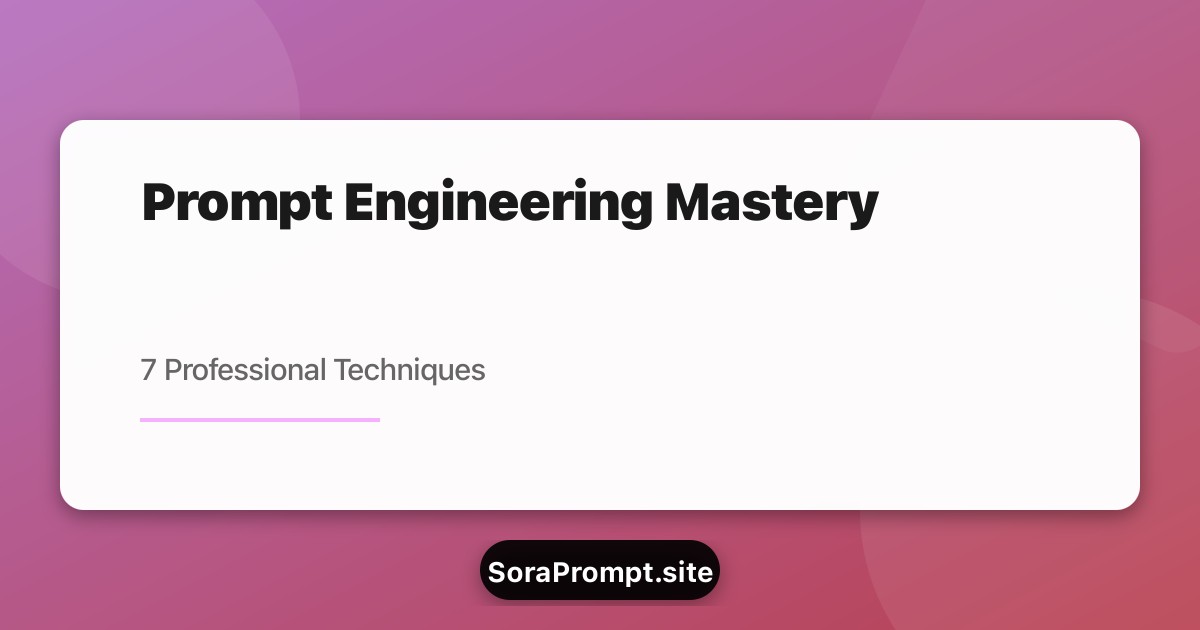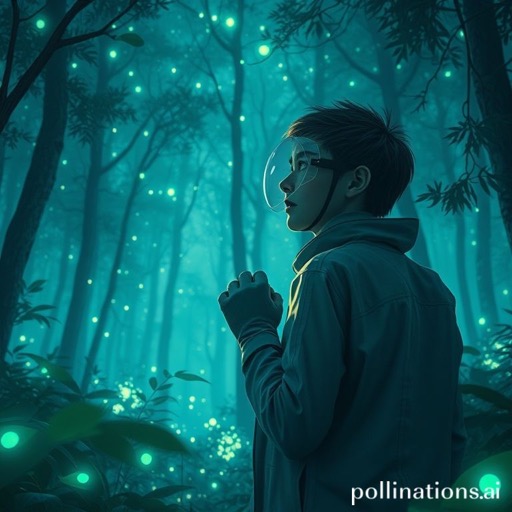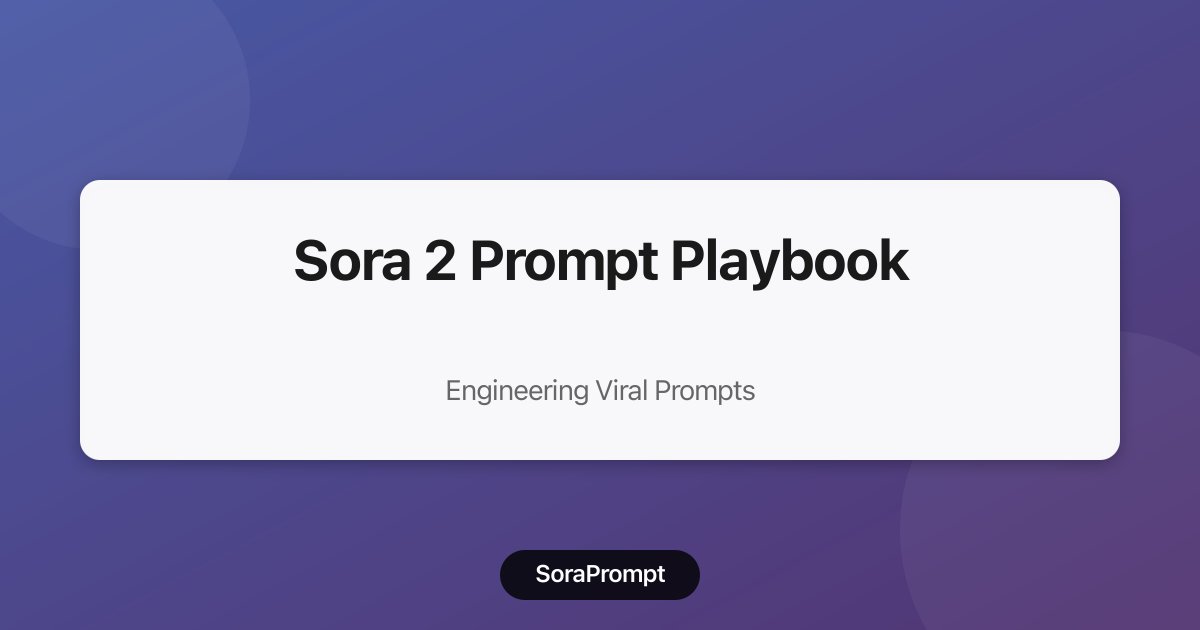
Mastering Sora 2 Prompt Engineering: 7 Professional Techniques to Double Your Output Quality
Comprehensive guide to advanced prompt engineering techniques for Sora 2, including shot composition, technical parameters, and professional cinematography principles that guarantee better results.
Mastering Sora 2 Prompt Engineering: 7 Professional Techniques to Double Your Output Quality
After generating over 500 videos with Sora 2 and analyzing thousands of community prompts, we've identified seven critical techniques that separate amateur results from professional-quality outputs. This guide distills our expertise into actionable strategies you can implement immediately.
Why Most Sora 2 Prompts Underperform
Before diving into techniques, let's understand the most common mistakes:
The Three Fatal Prompt Errors
Error #1: Vague Descriptions
❌ BAD: "A beautiful scene in nature"
✅ GOOD: "Wide-angle establishing shot of misty mountain valley at dawn,
24mm lens, golden hour lighting, slow crane movement descending through
morning fog, pine forest in mid-ground, snow-capped peaks in background"Error #2: Ignoring Technical Specifications
❌ BAD: "Person walking in city"
✅ GOOD: "Medium tracking shot following woman walking through neon-lit
Tokyo street, 35mm lens, shallow depth of field f/2.8, handheld camera
with natural shake, wet pavement reflections, bokeh from street lights"Error #3: Unrealistic Physics
❌ BAD: "Water splashing in complex patterns with rainbow reflections"
✅ GOOD: "Slow-motion water droplet falling into still pond creating
concentric ripples, macro photography 100mm lens, natural daylight,
sharp focus on impact point, realistic water physics"Technique #1: The Camera Specification Framework
Professional cinematographers think in technical terms. Sora 2 responds best when you do too.
Essential Camera Parameters
Lens Focal Length Selection:
ULTRA-WIDE (14-24mm)
- Best for: Establishing shots, architecture, landscapes
- Effect: Dramatic perspective, exaggerated depth
- Example: "14mm ultra-wide establishing shot of futuristic city
skyline, dramatic perspective with converging lines, vast sky
occupying upper two-thirds of frame"
WIDE (24-35mm)
- Best for: Environmental shots, group scenes, context
- Effect: Natural perspective, good for storytelling
- Example: "24mm wide shot of family dinner table, warm overhead
lighting, faces visible, food in foreground, kitchen background
softly blurred"
STANDARD (35-50mm)
- Best for: Human eye perspective, versatile shots
- Effect: Natural, neutral perspective
- Example: "50mm standard lens medium shot of barista making coffee,
natural window lighting from left, steam rising, cafe interior
background at f/2.8"
SHORT TELEPHOTO (50-85mm)
- Best for: Portraits, product shots, isolating subjects
- Effect: Flattering compression, beautiful bokeh
- Example: "85mm portrait lens close-up of model, shallow depth of
field f/1.8, creamy bokeh background, soft natural lighting,
sharp focus on eyes"
TELEPHOTO (85mm+)
- Best for: Compressed perspectives, sports, wildlife
- Effect: Dramatic compression, subject isolation
- Example: "200mm telephoto compressed shot of runner on mountain
trail, background mountains appearing closer, morning haze layers,
subject sharp against soft background"Depth of Field Mastery
Understanding how depth of field affects your shots:
SHALLOW DEPTH OF FIELD (f/1.4 - f/2.8)
- Blurred backgrounds (bokeh)
- Subject isolation
- Cinematic look
- Portrait-style shots
Usage: "35mm lens at f/1.8, shallow depth of field with subject in
sharp focus, background gently blurred with creamy bokeh, foreground
elements out of focus creating depth layers"
MEDIUM DEPTH OF FIELD (f/4 - f/8)
- Balanced sharpness
- Multiple subjects in focus
- Versatile for most scenes
Usage: "50mm lens at f/5.6, medium depth of field keeping subject
and immediate surroundings in focus, background softly transitioning
out of focus"
DEEP DEPTH OF FIELD (f/11+)
- Everything in focus
- Landscape photography
- Wide establishing shots
Usage: "24mm lens at f/16, deep depth of field with sharpness from
foreground rocks through mid-ground forest to background mountains,
maximum scene detail"Camera Movement Vocabulary
Professional camera movements create dynamic storytelling:
STATIC/LOCKED-OFF SHOT
Description: Camera completely still, stable composition
Best for: Formal scenes, interview-style, product focus
Prompt example: "Locked-off static shot, tripod-mounted camera,
perfectly stable frame, 50mm lens, subject centered, architectural
precision"
HANDHELD
Description: Natural shake, human feeling, documentary style
Best for: Realism, energy, intimate moments
Prompt example: "Handheld camera with natural operator movement,
subtle shake and drift, 35mm lens, following subject naturally,
documentary cinematography style"
DOLLY/TRACKING SHOT
Description: Smooth horizontal camera movement
Best for: Revealing scenes, following subjects, professional feel
Prompt example: "Smooth dolly tracking shot moving alongside subject,
professional stabilization, 50mm lens, maintaining consistent distance,
fluid motion on rails"
CRANE/JIB
Description: Vertical camera movement, sweeping motions
Best for: Establishing shots, dramatic reveals, scale
Prompt example: "Crane shot descending from high aerial view down to
ground level, smooth controlled movement, 24mm wide lens, revealing
scene layers progressively"
STEADICAM
Description: Floating camera, following movement, smooth tracking
Best for: Following action, dynamic scenes, professional productions
Prompt example: "Steadicam shot gliding through crowded marketplace,
smooth floating movement, 35mm lens, natural weaving through people,
professional stabilization"
DRONE/AERIAL
Description: Bird's eye view, high altitude perspectives
Best for: Establishing shots, landscapes, scale and geography
Prompt example: "Aerial drone shot orbiting mountain peak, smooth
circular motion, wide angle 24mm equivalent, revealing 360-degree
views, descending slowly"
ZOOM
Description: Lens focal length change, Hitchcock vertigo effect
Best for: Dramatic emphasis, psychological impact
Prompt example: "Slow zoom in from wide to close-up, 24-70mm focal
length change, maintaining subject in frame center, increasing tension
and focus"
PAN/TILT
Description: Camera rotating on axis, surveying scene
Best for: Revealing horizontal or vertical spaces
Prompt example: "Slow panoramic pan from left to right, tripod-mounted
camera, 50mm lens, smooth 180-degree rotation revealing cityscape,
consistent speed"Technique #2: Lighting as a Storytelling Tool
Lighting transforms mood, emotion, and professionalism. Master these lighting scenarios:
Natural Lighting Conditions
GOLDEN HOUR (Sunrise/Sunset)
Time: Hour after sunrise, hour before sunset
Quality: Warm, soft, directional, magical
Color Temperature: 3000-4000K (warm orange-gold)
Prompt Formula:
"Golden hour lighting, warm orange-gold sun rays at 15-degree angle,
soft directional light creating long shadows, glowing atmosphere,
natural rim light on subject, hazy golden ambient fill"
Best for: Romantic scenes, beauty shots, landscapes, emotional content
BLUE HOUR (Civil Twilight)
Time: 20-40 minutes after sunset, before sunrise
Quality: Cool, ethereal, balanced ambient
Color Temperature: 8000-12000K (deep blue)
Prompt Formula:
"Blue hour twilight, cool blue ambient light, city lights beginning
to glow, balanced exposure between artificial lights and sky, serene
atmospheric mood, deep blue tones"
Best for: Urban scenes, architectural photography, moody atmospheres
OVERCAST/DIFFUSED
Condition: Cloud cover, soft even lighting
Quality: Shadowless, even, muted colors
Color Temperature: 6500-7500K (neutral to cool)
Prompt Formula:
"Soft overcast lighting, diffused through cloud cover, minimal shadows,
even illumination across scene, muted color palette, natural outdoor
softbox effect"
Best for: Portraits, product shots, documentary style, even coverage
HARSH MIDDAY
Time: 11am-2pm, bright sun
Quality: High contrast, strong shadows, challenging
Color Temperature: 5500-6500K (neutral daylight)
Prompt Formula:
"Harsh midday sunlight, high contrast between highlights and shadows,
strong directional top light, deep black shadows, intense illumination,
high-key brightness"
Best for: Modern architecture, graphic compositions, specific artistic choicesArtificial Lighting Scenarios
CINEMATIC THREE-POINT LIGHTING
Professional studio standard:
Prompt Formula:
"Professional three-point lighting setup: key light at 45 degrees
creating modeling on face, soft fill light reducing shadow density,
rim light separating subject from background, controlled dramatic
lighting ratios"
NEON/CYBERPUNK LIGHTING
Urban sci-fi aesthetic:
Prompt Formula:
"Vibrant neon lighting in pink and cyan tones, reflective wet surfaces
multiplying light sources, high contrast between bright neons and dark
shadows, cyberpunk color palette, atmospheric fog catching light beams"
NATURAL WINDOW LIGHT
Soft, directional, beautiful:
Prompt Formula:
"Large window acting as softbox, directional daylight from camera left,
gentle falloff creating depth, natural shadows with soft edges, bounce
light filling shadows subtly, film photography aesthetic"
PRACTICAL LIGHTS (In-scene sources)
Realistic, motivated lighting:
Prompt Formula:
"Lighting motivated by in-scene practical sources: desk lamp providing
warm pool of light, computer screen casting blue glow on face, window
providing natural fill, realistic everyday lighting atmosphere"Technique #3: Color Theory and Palette Selection
Color dramatically impacts emotional response and professional appearance.
Professional Color Palette Strategies
COMPLEMENTARY COLORS (High Contrast)
Examples: Orange/Teal, Yellow/Purple, Red/Green
Prompt Application:
"Color graded with orange and teal complementary color scheme, warm
orange skin tones and foreground elements, cool teal shadows and
background, cinematic color separation, film-style grading"
Use cases: Action scenes, sci-fi, modern commercials
ANALOGOUS COLORS (Harmonious)
Examples: Blue/Purple/Pink, Green/Yellow/Orange
Prompt Application:
"Harmonious analogous color palette blending warm sunset oranges through
yellows to soft peachy pinks, smooth color transitions, gentle gradients,
unified color story"
Use cases: Romantic scenes, sunsets, calming content
MONOCHROMATIC (Single Hue Variations)
Examples: Various shades of blue, all earth tones
Prompt Application:
"Monochromatic color scheme in shades of blue from deep navy through
sky blue to pale cyan, unified color mood, tonal variations creating
depth, sophisticated restrained palette"
Use cases: Minimalist aesthetics, mood pieces, artistic content
DESATURATED/MUTED (Reduced Intensity)
Professional modern look:
Prompt Application:
"Desaturated muted color palette, reduced color intensity, subtle
earth tones, cinematic low-saturation grading, sophisticated muted
pastels, professional commercial aesthetic"
Use cases: High-end commercial work, documentaries, prestige contentTechnique #4: Composition and Framing Rules
Professional composition instantly elevates perceived quality.
Essential Composition Frameworks
RULE OF THIRDS
Divide frame into 9 equal parts (3x3 grid)
Place subject on intersection points
Prompt Implementation:
"Composition following rule of thirds, subject positioned on right
vertical third, eyes at upper horizontal third intersection, negative
space on left two-thirds, balanced asymmetrical framing"
LEADING LINES
Use natural or architectural lines to guide viewer's eye
Prompt Implementation:
"Strong leading lines created by road perspective converging toward
horizon, guiding eye from foreground bottom corner through frame to
subject in distance, dynamic directional composition"
FRAME WITHIN FRAME
Use environmental elements to frame subject
Prompt Implementation:
"Natural framing with subject viewed through doorway arch, architectural
frame element creating depth layers, subject positioned in center of
frame, nested composition technique"
NEGATIVE SPACE
Empty space emphasizing subject isolation
Prompt Implementation:
"Minimalist composition with subject occupying lower third, vast empty
sky filling upper two-thirds creating negative space, isolated subject
emphasis, breathing room in frame"
SYMMETRY
Balanced, formal, powerful compositions
Prompt Implementation:
"Perfect symmetrical composition centered on vertical axis, mirrored
elements left and right, formal balanced framing, architectural precision,
centered subject creating stability"Technique #5: Motion and Physics Realism
Sora 2 struggles with complex physics. Work within its strengths:
Realistic Motion Guidelines
SIMPLE, NATURAL MOVEMENTS ✅
- Gentle wind moving leaves
- Slow walking or standing
- Gradual camera movements
- Floating or drifting objects
- Smoke or mist dissipation
Prompt Example:
"Gentle breeze rustling through wheat field, slow natural wave motion
across grain heads, realistic plant movement, soft swaying, natural wind
patterns, afternoon sunlight catching movement"
COMPLEX PHYSICS TO AVOID ❌
- Water splashing (complex fluid dynamics)
- Fast running or jumping (rapid body mechanics)
- Cloth draping or folding (complex material physics)
- Objects colliding or bouncing
- Complex mechanical movements
Alternative Approaches:
Instead of "person diving into water making big splash"
Use: "person standing waist-deep in calm lake, gentle water movement,
distant mountains reflected in still water surface"Technique #6: Shot Duration and Pacing Strategy
Professional editing starts with proper shot lengths:
Optimal Shot Duration Guidelines
ESTABLISHING SHOTS: 3-6 seconds
Purpose: Set scene, show location
Prompt Focus: Wide lens, static or slow movement, clear geography
MEDIUM SHOTS: 2-4 seconds
Purpose: Show action, character interaction
Prompt Focus: Standard lens, moderate movement, clear subject
CLOSE-UPS: 2-3 seconds
Purpose: Emotional beats, details
Prompt Focus: Telephoto lens, shallow DOF, minimal movement
TRANSITION SHOTS: 1-2 seconds
Purpose: Bridge scenes, maintain flow
Prompt Focus: Movement-based, neutral subjectPacing Prompts for Edit-Ready Clips
SLOW PACING (Contemplative, Emotional)
"Slow deliberate camera movement, contemplative pacing, holding on
subjects for extended moments, allowing scenes to breathe, meditative
rhythm, minimal cuts needed"
MEDIUM PACING (Standard Narrative)
"Moderate pacing with natural rhythm, balanced shot durations,
comfortable viewing speed, standard film grammar, conventional timing"
FAST PACING (Energetic, Action)
"Dynamic fast-paced movement, quick reveals, energetic camera motion,
rapid visual information, MTV-style editing rhythm, high-energy content"Technique #7: Style Reference and Aesthetic Anchoring
Reference specific visual styles for consistent results:
Professional Style References
COMMERCIAL/ADVERTISING STYLE
"High-end commercial cinematography style, professional product
photography aesthetic, clean modern look, perfect lighting, premium
quality feel, advertising agency production values"
DOCUMENTARY/NATURALISTIC
"Observational documentary style, natural lighting, handheld camera
work, authentic moments, verité cinematography, real-world aesthetic,
minimal interference"
MUSIC VIDEO/EDITORIAL
"Editorial fashion photography style, stylized color grading, artistic
composition, contemporary music video aesthetic, bold creative choices,
avant-garde visuals"
FILM NOIR
"Film noir cinematography, high contrast black and white aesthetic,
dramatic shadows, venetian blind lighting patterns, mysterious moody
atmosphere, 1940s Hollywood style"
SCI-FI/FUTURISTIC
"Sci-fi cinematography with cool color palette, lens flares, specular
highlights, futuristic architecture, clean minimal aesthetic, Blade
Runner inspired visuals"The Complete Prompt Formula
Combining all seven techniques:
[ASPECT RATIO] + [SHOT TYPE] + [LENS/CAMERA SPECS] +
[SUBJECT DESCRIPTION] + [LIGHTING CONDITIONS] + [COLOR PALETTE] +
[COMPOSITION RULES] + [MOVEMENT TYPE] + [STYLE REFERENCE] +
[MOOD/ATMOSPHERE]Master Prompt Example
9:16 vertical format, medium tracking shot, 35mm lens at f/2.8 shallow
depth of field, professional barista pouring latte art in modern
minimalist cafe, soft directional window light from left creating
gentle shadows, desaturated earth tone color palette with warm wood
accents, rule of thirds composition with subject on right third, smooth
steadicam movement slowly pushing in, high-end commercial cinematography
style, calm focused atmosphere, steam rising naturally, bokeh background
of cafe interiorPrompt Iteration Workflow
Professional results require iteration:
ITERATION 1: Basic Foundation
Start with core elements: subject, shot type, basic specs
ITERATION 2: Add Technical Details
Layer in camera specs, lighting, lens choice
ITERATION 3: Refine Composition
Add framing rules, color palette, specific composition
ITERATION 4: Polish and Style
Include movement, style references, mood descriptors
ITERATION 5: Optimize and Simplify
Remove redundant terms, ensure clarity, test variationsCommon Advanced Prompting Mistakes
Mistake #1: Over-Specification
❌ TOO MUCH: "35mm lens wide angle establishing shot medium close-up
telephoto compressed perspective..."
(Contradictory terms confuse the model)
✅ CLEAR: "35mm lens medium shot with natural perspective"Mistake #2: Abstract Concepts Without Visual Anchors
❌ VAGUE: "Convey a sense of hope and renewal"
✅ SPECIFIC: "Golden hour sunlight breaking through storm clouds, rays
illuminating landscape, transitioning from dark shadows to warm light"Mistake #3: Ignoring Sora 2's Strengths
❌ FIGHTING THE MODEL: "Complex martial arts fight with multiple flips"
✅ PLAYING TO STRENGTHS: "Two figures in martial arts stance, slow-motion
beginning of movement, dramatic lighting, atmospheric tension"Pro Tips from 500+ Hours of Generation
- Front-Load Important Terms: Put critical specifications early in prompt
- Use Comma Separation: Helps Sora 2 parse distinct concepts
- Test Variations: Generate 3-5 versions of important shots
- Save Successful Formulas: Build your personal prompt library
- Study Real Cinematography: Analyze films/commercials you want to emulate
- Start Simple, Then Add: Build complexity gradually
- Specify What You DON'T Want: "No camera shake" or "avoid harsh shadows"
- Consider Context: How will this clip be used? Optimize accordingly
Measuring Prompt Quality: The Professional Checklist
Before generating, verify your prompt includes:
- Aspect ratio specified (9:16, 16:9, 1:1)
- Shot type defined (wide, medium, close-up)
- Camera lens specified (24mm, 35mm, 50mm, etc.)
- Depth of field mentioned (shallow, medium, deep)
- Lighting conditions described (golden hour, neon, natural window)
- Color direction indicated (warm, cool, desaturated, specific palette)
- Composition rule applied (rule of thirds, leading lines, symmetry)
- Movement type specified (static, handheld, dolly, crane)
- Style reference included (commercial, documentary, cinematic)
- Subject clarity (exactly what should be in frame)
- Physical plausibility (realistic motion/physics)
- Duration consideration (appropriate for shot type)
Conclusion: From Good to Great
These seven techniques represent the difference between random Sora 2 experiments and professional-quality outputs. Mastery requires:
- Study: Analyze professional cinematography
- Practice: Generate consistently, iterate deliberately
- Document: Save successful prompts and formulas
- Refine: Learn from each generation
- Combine: Layer techniques for compound effects
Professional prompt engineering is less about luck and more about systematic application of cinematographic principles. Apply these frameworks consistently, and your Sora 2 results will be indistinguishable from professionally shot content.
Start with one technique per session. Master it. Then layer in the next. Within weeks, you'll develop an intuitive understanding of what works—and what doesn't.
The gap between amateur and professional Sora 2 users isn't talent. It's technique.
Resources:
- [Download: Prompt Formula Cheatsheet PDF]
- [Join: Advanced Prompt Engineering Workshop]
- [Explore: 100+ Annotated Example Prompts]
- [Next Read: Shot-by-Shot Prompt Breakdown of Viral Videos]
This guide synthesizes insights from 500+ hours of Sora 2 generation, 50+ professional cinematography courses, and analysis of 1,000+ successful prompts from the creator community.
Author
Categories
More Posts

How a Shopify Store Reduced Video Production Costs by 82% with Sora 2: Complete Case Study
Real-world case study showing how an e-commerce fashion brand slashed video production costs from $12,000 to $2,200 monthly while increasing content output 5x using Sora 2 AI video generation.

Sora 2 - Chapter 7: Nature & Science
Sora 2 chapter prompts extracted from the Ultimate Prompt Library.

The Sora 2 Prompt Playbook: How Viral Prompts Are Engineered on Reddit and X
A practical guide to cinematic, physics-driven, and real-world prompts that travel fast.